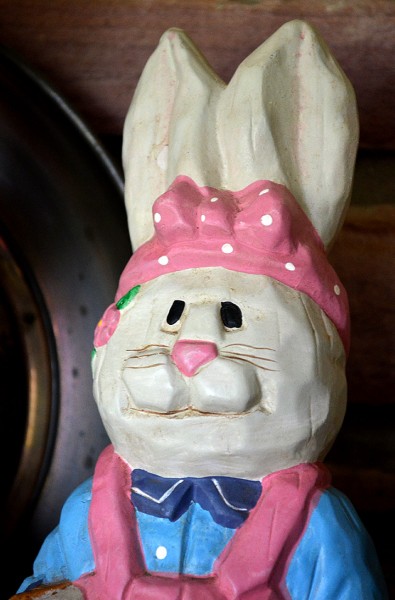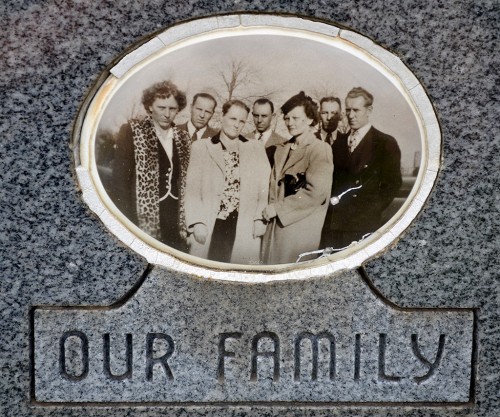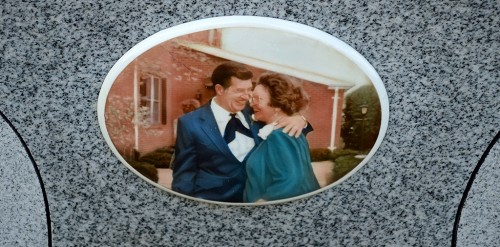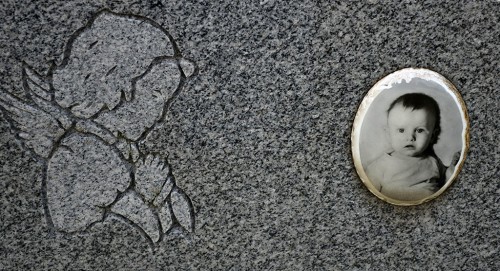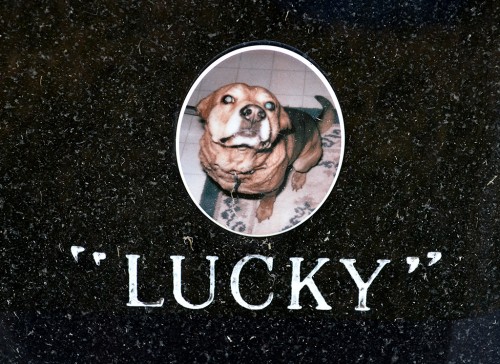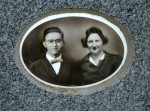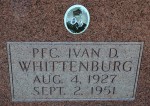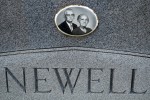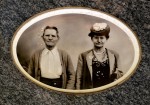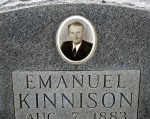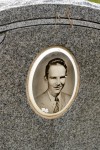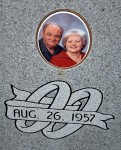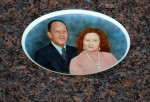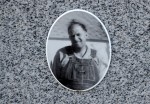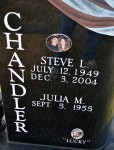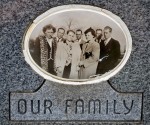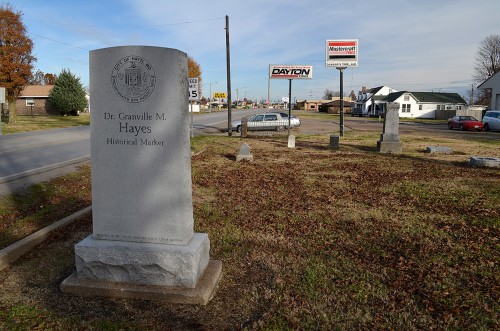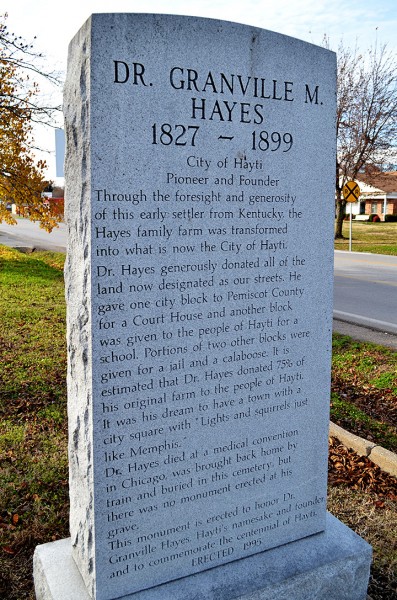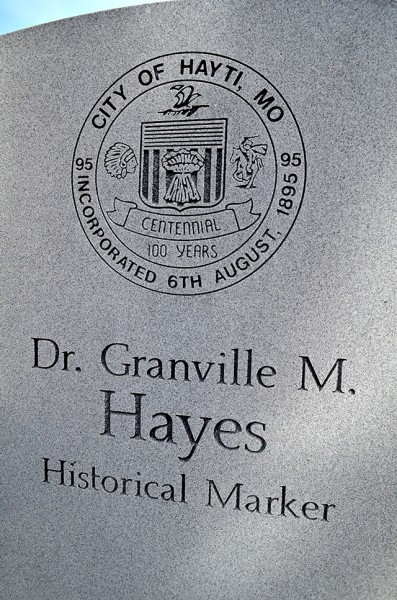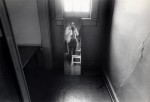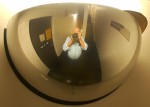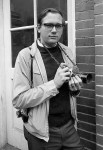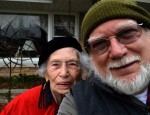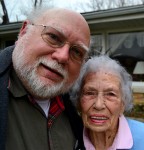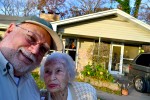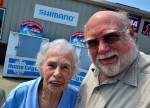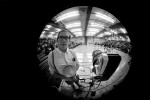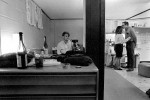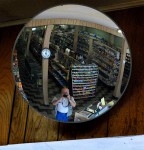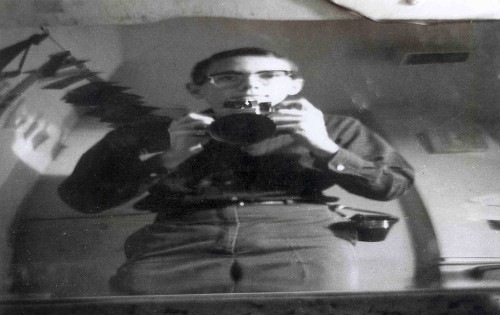 Hi, I’m Ken, and I’ve shot selfies. It has been approximately 3-1/2 months since my last selfie.
Hi, I’m Ken, and I’ve shot selfies. It has been approximately 3-1/2 months since my last selfie.
I offer up that confession because I’ve made fun of folks who shoot them, most recently at an Ohio University football game I covered last fall. Then, while looking for a photo, I started realizing how many self-portraits I had taken over the years. I have been in serious denial.
One of the earliest I could find was my reflection on the photo print dryer in the Central High School darkroom. The dryer’s shiny metal plates that imparted a glossy surface on the print when it dried served as a great curved mirror..
Not my Budweiser towel
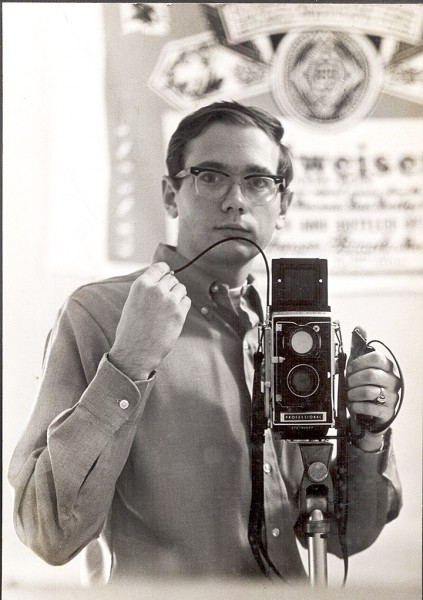 Early on in one of my Ohio University photo classes, we had to take some self-portraits. This was my reflection in a mirror in the Scott Quadrangle dorm room I shared with two freshmen. The Bud towel belonged to one of them. It was what passed for decoration in what was primarily a freshman dorm.
Early on in one of my Ohio University photo classes, we had to take some self-portraits. This was my reflection in a mirror in the Scott Quadrangle dorm room I shared with two freshmen. The Bud towel belonged to one of them. It was what passed for decoration in what was primarily a freshman dorm.
I’m shooting it with a Mamyia C33 twin lens reflex I bought used from Nowell’s Camera Shop. A serviceman coming back from Vietnam sold it and three lenses for $300. I hated the square format, but 2-1/4 x 2-1/4 was required for at least one of my classes. I sold it as quickly as I could.
Always hiding behind camera
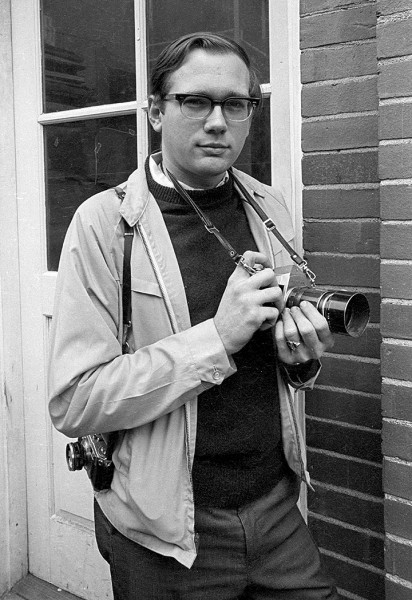 There’s a common theme in most of these photos: I’m almost always hiding behind a camera. This was shot March 7, 1968.
There’s a common theme in most of these photos: I’m almost always hiding behind a camera. This was shot March 7, 1968.
Let’s climb on a rooftop
 This was taken right after the precvious shot. I figured anybody could take a photo on the ground, so I climbed on top of the Beckley building in uptown Athens to get this portrait with the county courthouse in the background. If you can’t make it good, at least make it unusual. I used that vantage point a lot over the next several years.
This was taken right after the precvious shot. I figured anybody could take a photo on the ground, so I climbed on top of the Beckley building in uptown Athens to get this portrait with the county courthouse in the background. If you can’t make it good, at least make it unusual. I used that vantage point a lot over the next several years.
The long arm of the photographer
 This looks more like today’s selfie. My arm must have been longer in those days because I have trouble shooting them today. I know the lens was wider in 1968 and I’m wider in 2014, so the combination of those things may make it tougher. This was shot in the photo lab at The Athens Messenger.
This looks more like today’s selfie. My arm must have been longer in those days because I have trouble shooting them today. I know the lens was wider in 1968 and I’m wider in 2014, so the combination of those things may make it tougher. This was shot in the photo lab at The Athens Messenger.
Note the psychedelic poster on the wall. That, like the Bud towel, wasn’t my decoration. I’ll blame Bob Rogers or Jon Webb for it.
Multiple light assignment
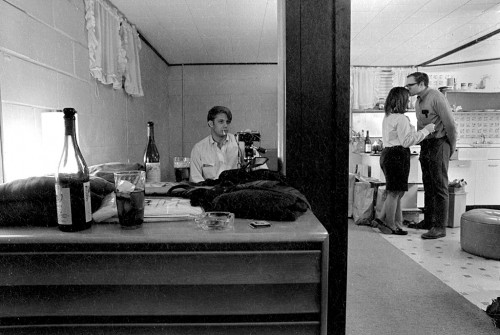 Lots of photo class assignments were finger exercises to teach us technique. Most of them were intended to be shot in a studio, but I was lousy at studio lighting and I thought it was boring, so I’d work outside the box. I’m sure some of the instructors weren’t happy with the way I bent the rules, but they couldn’t kick the image back because I hadn’t exactly broken them.
Lots of photo class assignments were finger exercises to teach us technique. Most of them were intended to be shot in a studio, but I was lousy at studio lighting and I thought it was boring, so I’d work outside the box. I’m sure some of the instructors weren’t happy with the way I bent the rules, but they couldn’t kick the image back because I hadn’t exactly broken them.
This shot was taken in Bob Rogers’ basement apartment on November 14, 1968. (That’s Bob in the foreground.) In the pre-digital days, you didn’t know immediately if you got the shot or not, so you shot multiple exposures to hedge your bets. This picture had three or more lights that had to be balanced, so it took lots of exposures with Bob and Wife Lila being very patient. In this shot, I’m going out to assure her that we are almost done.
Trying something new
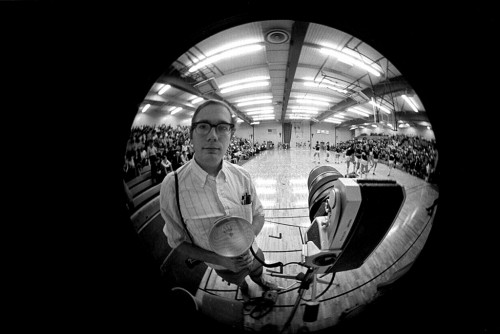 When you cover as many high school and college ball games as Bob and I did, you start looking for something different. One night we decided to go as far in as different photographic directions as possible: I set up a camera with a wideangle fisheye lens, and he shot with a 500mm telephoto. So far as I know, that was the ONLY time we ever tried that.
When you cover as many high school and college ball games as Bob and I did, you start looking for something different. One night we decided to go as far in as different photographic directions as possible: I set up a camera with a wideangle fisheye lens, and he shot with a 500mm telephoto. So far as I know, that was the ONLY time we ever tried that.
John J. Lopinot was the triggerman
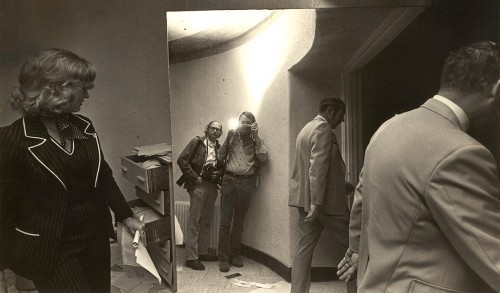 This may not technically qualify as a selfie because my finger’s not on the trigger (or self-timer.) Chief photographer John J. Lopinot and I went on a tour of Palm Beach’s Roaring ’20s Biltmore Hotel when it looked like it might be torn down. (It’s been converted into upscale condo apartments, thankfully.)
This may not technically qualify as a selfie because my finger’s not on the trigger (or self-timer.) Chief photographer John J. Lopinot and I went on a tour of Palm Beach’s Roaring ’20s Biltmore Hotel when it looked like it might be torn down. (It’s been converted into upscale condo apartments, thankfully.)
We spotted a mirror in the hallway and Lopi took the shot. I like the interesting juxtaposition of the man on the right who shows up twice and the woman giving us the strange look.
My shot from the Biltmore
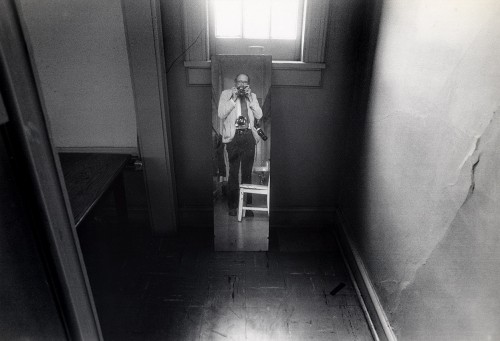 We came upon another mirror later in the walk and I took a solo portrait. I’m shooting with a 24mm wideangle lens and am carrying bodies with 105mm and 200mm lenses.
We came upon another mirror later in the walk and I took a solo portrait. I’m shooting with a 24mm wideangle lens and am carrying bodies with 105mm and 200mm lenses.
I loved curved mirrors
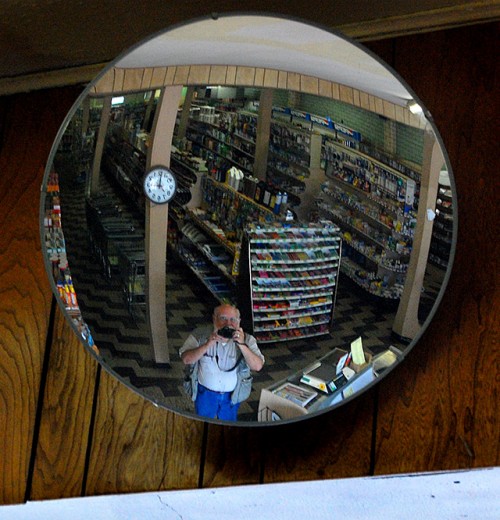 I was always a sucker for curved mirrors. I’ve taken some I like better but couldn’t lay my fingers on them at 2 in the morning. This mirror is in the Altenburg Foods grocery store that closed for good shortly after I photographed it.
I was always a sucker for curved mirrors. I’ve taken some I like better but couldn’t lay my fingers on them at 2 in the morning. This mirror is in the Altenburg Foods grocery store that closed for good shortly after I photographed it.
Barbershop when I had hair
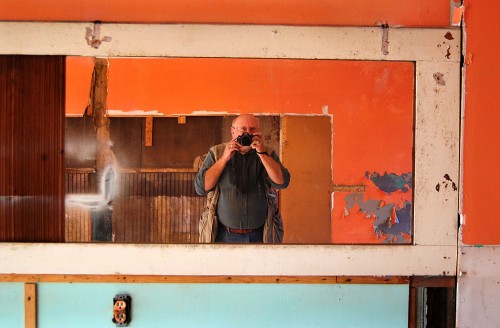 This was taken in what used to be Ed Unger’s Stylerite Barber Shop on Sprigg Street. I used to get my hair cut there when I still had some to cut.
This was taken in what used to be Ed Unger’s Stylerite Barber Shop on Sprigg Street. I used to get my hair cut there when I still had some to cut.
Departure selfies
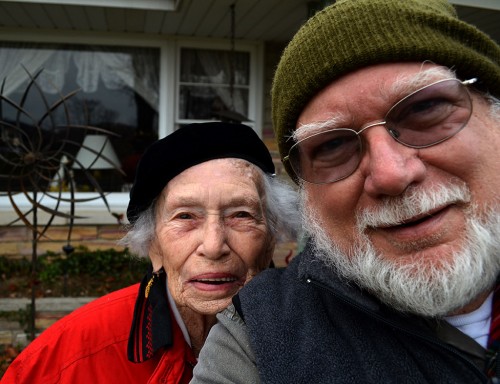 Since I’m usually leaving Cape by myself, I’ve had to start resorting to selfies to get the departure shot with Mother. This is the last one I took, and the one I mentioned in my confession above. It was taken November 25, 2013. To see some of the others, you’ll have to go to the gallery below. I need longer arms or a wider lens.
Since I’m usually leaving Cape by myself, I’ve had to start resorting to selfies to get the departure shot with Mother. This is the last one I took, and the one I mentioned in my confession above. It was taken November 25, 2013. To see some of the others, you’ll have to go to the gallery below. I need longer arms or a wider lens.
Ken’s photo gallery
Here’s a gallery of me getting older and grayer in my self-portraits. Click on any photo to make it larger, then use your arrow keys to move through the gallery. Now that I am out of denial, I’ll refrain from making fun of other folks who take pictures of themselves.
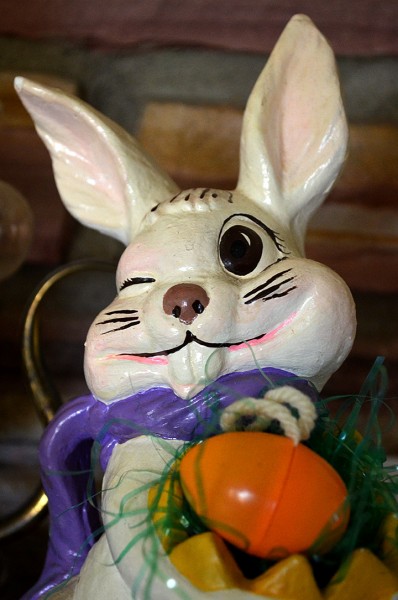 One of the problems / advantages of retirement is that you don’t have to know what day of the week it is. I shot these Easter decorations in Mother’s living room before we embarked on a ramble. Some of them, like the clear plastic tree with the ornaments on it, have been around since I was a kid.
One of the problems / advantages of retirement is that you don’t have to know what day of the week it is. I shot these Easter decorations in Mother’s living room before we embarked on a ramble. Some of them, like the clear plastic tree with the ornaments on it, have been around since I was a kid.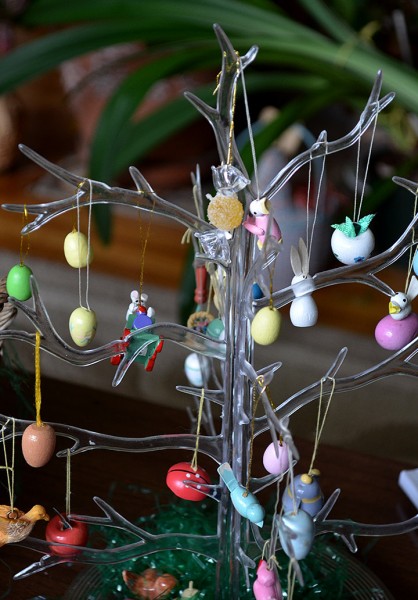 During a lull in the conversation, Mother leaned over me and asked him, “Do you know what day this is?”
During a lull in the conversation, Mother leaned over me and asked him, “Do you know what day this is?”
